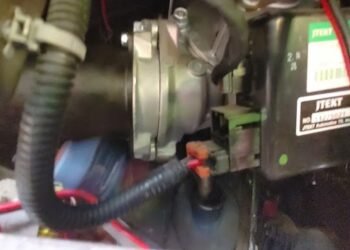Your car won’t start, and you’re left stranded. This is a common issue that many drivers face.
Understanding why a car won’t start can save you time and stress. It might be a simple fix or something more serious, but knowing the basics can help. Imagine being ready for an important meeting, and your car just won’t start.
Frustrating, right? Several factors can cause this problem, ranging from a dead battery to a faulty starter. By learning the common reasons behind this issue, you can diagnose and possibly fix it yourself. This blog will guide you through the potential causes and solutions, ensuring you’re better prepared next time your car won’t start. Let’s dive into the details and get your car back on the road!
Battery Issues
One of the most common reasons a car won’t start is due to battery issues. The battery is essential for the vehicle’s electrical system. It powers everything from the ignition to the lights. Understanding battery problems can help you diagnose why your car isn’t starting.
Dead Battery
A dead battery is a frequent cause of a car not starting. Batteries can die for various reasons. This includes leaving the lights on overnight or not driving the car for a long time. When the battery is dead, the engine does not get the power it needs to start.
To check if your battery is dead, try turning on the headlights. If they are dim or do not turn on at all, the battery might be the problem. Using a multimeter can also help measure the battery’s voltage. A healthy battery should show around 12.6 volts.
| Symptom | Possible Cause |
|---|---|
| Dim headlights | Low battery charge |
| No lights | Dead battery |
Corroded Battery Terminals
Corroded battery terminals can also prevent your car from starting. Corrosion on the terminals creates a poor connection. This can stop the battery from delivering power to the engine. Corrosion looks like a white or blue fuzzy substance on the battery terminals.
To fix this, you can clean the terminals. First, disconnect the battery. Then, use a mixture of baking soda and water to clean the corrosion. A wire brush can help scrub off the corrosion. Once clean, reconnect the battery and try starting the car again.
- Wear gloves to protect your hands
- Ensure the car is off before disconnecting the battery
- Reconnect the positive terminal first
By checking these battery issues, you can often find the cause of why your car won’t start. Addressing a dead battery or corroded terminals can get you back on the road quickly.

Credit: www.youtube.com
Starter Motor Problems
When your car won’t start, starter motor problems might be the cause. Understanding common starter issues can help you diagnose and fix the problem.
Faulty Starter
A faulty starter is a common reason for your car not starting. The starter motor cranks the engine. If it fails, the engine won’t turn over.
Signs of a faulty starter include:
- Clicking sound when you turn the key.
- Engine won’t crank at all.
- Starter stays on after the engine starts.
If you notice these signs, check the starter motor.
Worn-out Solenoid
The solenoid sends electric current to the starter motor. If the solenoid is worn-out, the starter motor won’t receive power.
Symptoms of a worn-out solenoid include:
- No sound when turning the key.
- Intermittent starting issues.
- Starter engages but engine doesn’t crank.
If your solenoid is worn-out, consider replacing it.
Fuel System Failures
Fuel system failures can cause your car to not start. Understanding the common problems can help you diagnose the issue quickly. Below are some of the frequent fuel system problems you might encounter.
Empty Gas Tank
An empty gas tank is a common reason for a car not starting. It’s easy to overlook, but it’s crucial to check. Ensure the gas gauge is functioning correctly. Sometimes, a faulty gauge might show fuel when the tank is empty. Always keep your tank at least a quarter full to avoid running out unexpectedly.
Clogged Fuel Filter
A clogged fuel filter can block fuel from reaching the engine. This prevents the car from starting. Over time, dirt and debris accumulate in the filter. This blockage can cause your engine to sputter or not start at all. Regular maintenance and timely replacement of the fuel filter can prevent this issue.
- Signs of a clogged fuel filter:
- Engine misfires
- Reduced engine performance
- Difficulty starting the car
Replacing the fuel filter every 20,000 to 30,000 miles is a good practice. Consult your car’s manual for specific recommendations.
| Fuel System Issue | Symptoms | Solution |
|---|---|---|
| Empty Gas Tank | Car won’t start, fuel gauge on empty | Refuel the car |
| Clogged Fuel Filter | Engine sputtering, poor performance | Replace the fuel filter |
Keeping an eye on these factors can save you from unexpected car trouble. Regular maintenance ensures your fuel system functions smoothly.

Credit: www.erieinsurance.com
Ignition Switch Faults
Dealing with a car that won’t start can be frustrating. One common cause is a problem with the ignition switch. The ignition switch is the component that powers up your vehicle’s electrical system. If it fails, your car won’t start. Let’s explore some common issues related to the ignition switch.
Broken Ignition Switch
A broken ignition switch can prevent your car from starting. Signs of a broken ignition switch include:
- Your car stalls while driving.
- Dashboard lights flicker.
- Power accessories stop working.
If you notice these signs, it might be time to replace the ignition switch.
Key Fob Issues
Modern cars use key fobs for ignition. If the key fob is faulty, your car won’t start. Here are some key fob issues to consider:
- Dead battery in the key fob.
- Damaged key fob.
- Interference with the key fob signal.
To fix key fob issues, try replacing the battery or using a spare key fob.
Alternator Malfunctions
When a car won’t start, alternator malfunctions are a common cause. The alternator generates power for your car’s electrical systems and charges the battery. If it fails, your car won’t have the power it needs.
Failed Alternator
A failed alternator can stop your car in its tracks. The alternator converts mechanical energy to electrical energy. It charges the battery and powers the electrical system. A bad alternator means the battery won’t charge. Your car will run out of power and won’t start.
- Dim headlights: If your headlights are dim, the alternator may be failing.
- Warning light: The battery light on your dashboard may turn on.
- Strange noises: A failing alternator can make a whining or grinding noise.
Loose Alternator Belt
A loose alternator belt can also cause starting problems. The belt connects the alternator to the engine. If the belt is loose, the alternator can’t generate power. This means the battery won’t charge.
| Signs of a Loose Belt | Symptoms |
|---|---|
| Battery warning light | The battery light may turn on. |
| Squealing noise | A loose belt can make a high-pitched squeal. |
| Battery drains quickly | The battery will lose power faster. |
Check the belt for damage or wear. If it’s loose, tighten or replace it. This can solve many starting issues.

Credit: www.autotechiq.com
Engine Overheating
Engine overheating is a common issue that can cause your car not to start. It usually happens when the engine gets too hot and shuts down to prevent damage. There are several reasons why your engine might be overheating. The most common ones involve problems with the coolant system. Let’s break it down into key areas you need to check.
Coolant Leaks
A significant cause of engine overheating is coolant leaks. The coolant helps keep your engine at the right temperature. If there is a leak, the coolant level drops, leading to overheating.
- Check for visible puddles under your car.
- Inspect the radiator and hoses for cracks or damage.
- Look for a sweet smell, which can indicate a coolant leak.
If you find a leak, you will need to repair or replace the affected parts. This will help restore the coolant system’s function.
Radiator Problems
Another common issue is radiator problems. The radiator removes heat from the coolant. If it’s not working, the engine can overheat.
Here are some signs of radiator issues:
- Check if the radiator fan is working.
- Look for debris blocking the radiator fins.
- Inspect for signs of corrosion or leaks on the radiator.
If the radiator is damaged, it might need cleaning, repair, or replacement. Ensuring your radiator is in good condition is crucial for maintaining a proper engine temperature.
Electrical System Glitches
Your car’s electrical system is complex. It controls many functions. If your car won’t start, it could be due to electrical system glitches. These issues often arise from components like fuses or wires. Let’s dive into two common culprits: blown fuses and faulty wiring.
Blown Fuses
Fuses protect your car’s electrical circuits. A blown fuse can stop the car from starting. Check the fuse box, which is usually near the dashboard or under the hood. Refer to your car’s manual for the fuse diagram. Look for any burnt or broken fuses.
| Common Symptoms | Possible Solutions |
|---|---|
| No dashboard lights | Replace the blown fuse |
| Radio not working | Check and replace the fuse |
Faulty Wiring
Wiring issues are harder to spot. Over time, wires can get damaged. This may cause your car not to start. Damaged wires can lead to short circuits. They can also cause a drain on the battery. Inspect the wires for any visible damage.
- Frayed wires
- Loose connections
- Corrosion on wires
If you find damaged wiring, it might be best to call a professional. Repairing or replacing wires can be tricky. Always ensure connections are tight and clean.
Quick Fixes
When your car won’t start, it can be frustrating. But don’t worry, some quick fixes might get your vehicle running again. Here, we will focus on two common solutions: Jump Starting and Using Fuel Additives.
Jump Starting
Jump starting is a fast and reliable way to get a dead battery going. You’ll need a pair of jumper cables and a second vehicle with a working battery. Follow these steps:
- Park the working car close to the dead car, but do not let them touch.
- Turn off both engines and open the hoods.
- Attach one end of the red cable to the positive terminal of the dead battery.
- Connect the other end of the red cable to the positive terminal of the working battery.
- Attach one end of the black cable to the negative terminal of the working battery.
- Connect the other end of the black cable to an unpainted metal surface on the dead car.
Start the working car and let it run for a few minutes. Then try starting the dead car. If it starts, remove the cables in reverse order and let the car run to recharge the battery.
Using Fuel Additives
Sometimes, a car won’t start because of issues with the fuel system. Using a fuel additive can help. Fuel additives clean the fuel injectors and improve fuel flow. Here is how to use them:
- Purchase a fuel additive from an auto parts store.
- Read the instructions on the bottle carefully.
- Pour the recommended amount into your gas tank.
- Fill up your tank with fresh fuel.
Start the car and let it run for a few minutes. The additive will clean the system and improve performance. This quick fix is simple and can be effective.
Frequently Asked Questions
Why Won’t My Car Start?
A dead battery could be the issue. Check the connections and try jump-starting.
What If My Car Clicks But Won’t Start?
This might be a sign of a weak battery or faulty starter. Check both.
Can A Bad Alternator Cause My Car Not To Start?
Yes, a failing alternator won’t charge the battery. Your car won’t start.
Why Does My Car Crank But Not Start?
Possible reasons include fuel issues, spark plug problems, or a faulty ignition switch.
What Should I Do If My Car Won’t Start In Cold Weather?
Check the battery. Cold can drain its power. Use a block heater if available.
Conclusion
Solving a car that won’t start can be frustrating. Start by checking the battery. Ensure it’s charged and connections are tight. Examine the fuel system for any issues. Look at the starter and ignition switch next. Regular maintenance prevents many common problems.
Keeping tools and a basic repair guide handy can be helpful. Remember, professional help is available if needed. Stay calm and follow these steps for a quick fix. Your car will likely be running smoothly again soon. Safe travels!
















